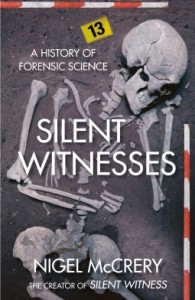

“Murder has a magic all of its own.” So said William Roughhead, a 19th century criminologist, and so opens Silent Witnesses: The Often Gruesome but Always Fascinating History of Forensic Science.
McCrery sets out to demonstrate the wizardry and science of forensic identification, which, as he notes, is "a history of uniqueness." The book is divided into chapters, with each section discussing the technological progression of one particular form of forensic evidence: fingerprints and physical identifiers, ballistics, blood, trace evidence, the body, poisons, and DNA. The writing is casual and conversational, with each technological advance accompanied by an anecdote that demonstrates the efficacy of the new technology. I was especially entertained by the unexpected details (for example, the first time fingerprints were used to solve a murder was in Argentina) and some of the more archaic anecdotes. (Did you know that in ancient China, handprints and fingerprints were used in evidence, and in Babylon, handprints were considered sufficiently individual to be used to seal legal contracts?) McCrery provides entertaining biographies of some of the most influential figures in the forensic sciences, such as Dr Joseph Bell, Doyle's main inspiration for Sherlock Holmes, as well as Alphonse Bertillon, the "Holmes of Paris" and man who introduced the idea of "photo-fit pictures." (In fact, in Hound of the Baskervilles, Holmes is described as second only to Bertillon.) McCrery also discusses a few crimes that I think may have been inspirations for other mystery writers. For instance, the cases of Dr. George Parkman and James Maybrick seem to me to be rather reminiscent of Whose Body and Strong Poison. I've begun to wonder if, like the contemporary Jonathan Kellerman, Dorothy L Sayers had a fondness for ripping some details of her plots from the headlines.
Whilst I rather enjoy the lurid stories of the long-distant past, more recent atrocities, especially ones in which McCrery acted as an investigator, felt far more ghoulish to me. Other than my distaste for these recent true-crime cases, the main place in which I think the book could be improved is the photographs that pepper the book. Even though photographs would be incredibly useful in illustrating some of the details such as differences in rifling or the equipment used in isolating poisons, most are of buildings or generic "forensic-ish" pictures that add little to no enlightenment.
Unlike the photographs, the stories themselves are varied and entertaining. They include tales of crooked expert witnesses, the struggles of pioneering scientists and detectives, and murders so outlandish that they belong in an Agatha Christie novel. Amongst a multitude of amusing anecdotes and sensational stories, here are a few of my favourites:
- Several entrepreneurial ladies have run profitable businesses in the industry of husband removal. For example, the lady Toffana di Adomo was so successful in marketing her "Acqua Toffana," supposedly a benign ladies' cosmetic, that she helped almost 600 women to become quite merry widows.
- The famed Samuel Colt, a runaway at the age of 16, did indeed make a gun (a special gun): his 6-shot was known as "the equalizer" because of a popular poem that was written about it: "Be not afraid of any man, no matter what his size. When danger threatens, call on me and I will equalize.”
- The freakiest poisoning case in the book is that of Georgi Markov. He was out walking one day when he suddenly felt a sharp pain in his leg. He thought it was due to the umbrella point of a passerby. In fact, the umbrella had been used as a weapon to shoot a tiny spherical metal pellet into his leg. The pellet, which contained a lethal dose of ricin, was sealed with a material that melted precisely at the temperature of the human body. (I kept waiting for someone in the story to show up with a mini-rocket cigarette or perhaps a shoe-phone.)
From explanations of Locard’s Exchange Principle (“Every contact leaves a trace”) to the details of the science behind "bullet fingerprinting" to pure hearsay like the story of the man who outsmarted a highwayman (he tricked him into taking a shot, and because early guns took so long to reload, was able to get his sword out before the gun was read again), Silent Witnesses is both entertaining and informative. If you're an inveterate mystery reader and interested in a casual, informal look at the history of forensics, this book is definitely worth a peek.
~~I received this ebook through NetGalley from the publisher, Chicago Review Press, in exchange for my honest review. ~~

 15
15




